Rebecca’s Recipe of the Week: Carrots Agrodolce
‘Agrodulce’, Italian for sour-sweet, is a technique for cooking vegetables in a mixture of oil, vinegar, salt and sugar. It’s very easy; 20 minutes should be ample, unless you like to take your time in cutting the carrots into matchsticks. The results are far greater than the sum of the parts. I don’t think you will have any left over; we certainly didn’t.
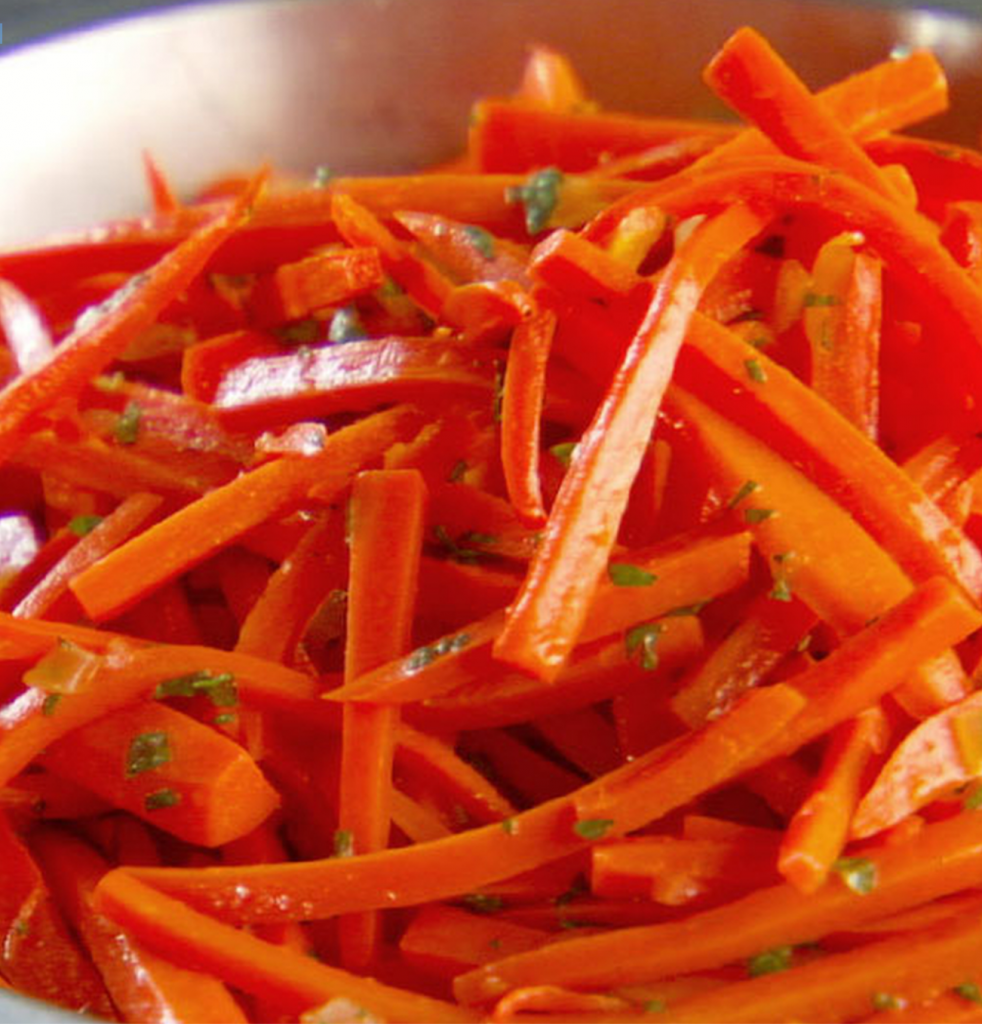
Carrots Agrodolce
Serves 3 as a side dish
Ingredients
500g carrots (peel and finely slice into matchsticks)
1½ tablespoons olive oil
1/3 cup of water
2 tablespoons minced onion
¾ teaspoon sugar
1 tablespoon red wine vinegar
¾ teaspoon salt
¼ teaspoon freshly ground black pepper
2 tablespoons fresh mint
Preparation
First cut the carrots into matchsticks. You can do this by cutting each carrot lengthwise into slabs, and then cutting each slab into thin thin matchsticks.
Place the carrots, olive oil, and water in a saucepan over medium-high heat. Bring to a boil and cook, uncovered, until the water has evaporated, which will take about 7 minutes.
Stir in the onion and cook for 1 minute. Add the sugar, vinegar, salt, and pepper, and stir until there is a glaze coating the carrots, about 30 seconds.
Remove from the heat and stir in the mint. Place in an attractive bowl and serve.
Recipe adapted from Mad Hungry.
Rebecca’s Recipe of the Week: Coconut, Potatoes, Beans
Meera Sodha’s East is excellent! Here is a gentle coconut-milk curry called an ‘istoo’, which is apparently derived from the English word ‘stew’. She recommends serving with aubergine pickle, and rice or an Indian flatbread. Some fried aubergine slices also go well.
Potato and Green Bean Istoo
Serves 2-3
Ingredients
2 tablespoons rapeseed oil
10 curry leaves
4cm cinnamon stick, broken in 2
1 medium onion (or 2 small onions), sliced
2cm piece of fresh ginger, peeled and grated
4 cloves of garlic, peeled and grated
1 green chile, slit in 2
650g small potatoes, halved
1 teaspoon each salt and pepper
1 400ml tin of coconut milk
250g green beans, topped and tailed
Preparation
In a casserole dish for which you have a lid, heat the oil on medium heat. Once it is hot add the curry leaves, cinnamon stick and onion. Reduce head to low and cook for 10 minutes, until the onion is soft but not brown. Add the ginger, garlic and chile, and cook for another 2-3 minutes.
Add the potatoes, salt and pepper and stir in the coconut milk. Then swill out the tin with about 100ml of water and add that to the pan as well. The potatoes should be just covered, so add more water if need be. Bring to a boil, and then reduce to a simmer and cook for 10-15 minutes, or until the potatoes are tender.
Add the beans, cover, and simmer for another 5 to 6 minutes, or until the beans are tender. Now it’s ready!
Recipe adapted from Meera Sodha, East (2019).
Rebecca’s Recipe of the Week: In Praise of Potatoes
In honour of the recent potato harvest, here is a splendid Nepalese potato salad from the Idaho Potato Commission. The Andean potato probably reached Nepal some time in the 1700s; it is now become a staple. In 2017 the country harvested 2,691,037 tonnes. This salad combines potatoes, fresh coriander, and spiced yoghurt to create a complex and satisfying dish. Eat with shredded carrot salad, and perhaps some flatbread.
The Potato Commission thinks this will serve 4 people, but we ate most of it in one sitting. ‘This is scrum’ declared Matt.
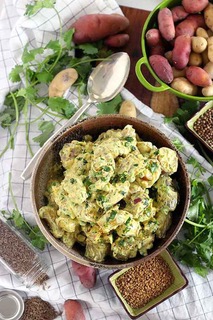
Chukauni: Nepalese Potato Salad
Ingredients
700g potatoes
1 cup frozen peas
½ cup red onion, finely chopped
½ cup fresh coriander, finely chopped
1 cup yoghurt, plus additional yoghurt, to serve
1 teaspoon salt
2 tablespoons rapeseed or vegetable oil
1 tablespoon coriander seeds
1 teaspoon cumin seeds
1 teaspoon fenugreek seeds
½ Canalside chile, finely chopped, seeds removed if desired
½ teaspoon turmeric
Preparation
Place the potatoes in a pot of cold water and bring slowly to the boil. Cook over very low heat until tender. Fish out the potatoes, drain, and set aside, keeping the water in the pan. Turn off the heat and then tip the peas into the hot water. Leave them there for 60 seconds and then drain them as well.
Once the potatoes are cool enough to handle, cut them into 2cm cubes.
Combine the peas, red onion, coriander, yoghurt and salt in a serving bowl. Stir and add the potatoes.
Heat the oil in a frying pan over medium-high heat. Once it is hot add the coriander, cumin and fenugreek seeds. Let sizzle for about 30 seconds, until they turn reddish brown. Remove from the heat and add the chile and turmeric. Toss so that the oil turns a sunny yellow.
Pour the oil–but not the seeds—over the salad. Keep as many seeds as possible back in the pan. Mix the oil into the salad and taste.
Now you have a choice: if the salad strikes you as perfectly delicious as it is, then you’re done. Serve and enjoy, with additional yoghurt on the side if you like.
If you think it needs a little more oomph, then scrape the seeds into a mortar and pestle and grind them until they’re a coarse powder. Sprinkle some or all of this into the salad, tasting as you go along. Once you’re pleased with the result, serve and enjoy.
Recipe adapted from the Idaho Potato Commission.
Rob’s Recipe of the Week: Road trip pasta
This week I’m keeping it simple and taking a little inspiration from a recent roadtrip to Italy. The spinach and tomato are pretty core to the dish but feel free to pick and choose from the rest of the list depending what you’ve got – I use an app called plant jammer to figure out what things might go well together.
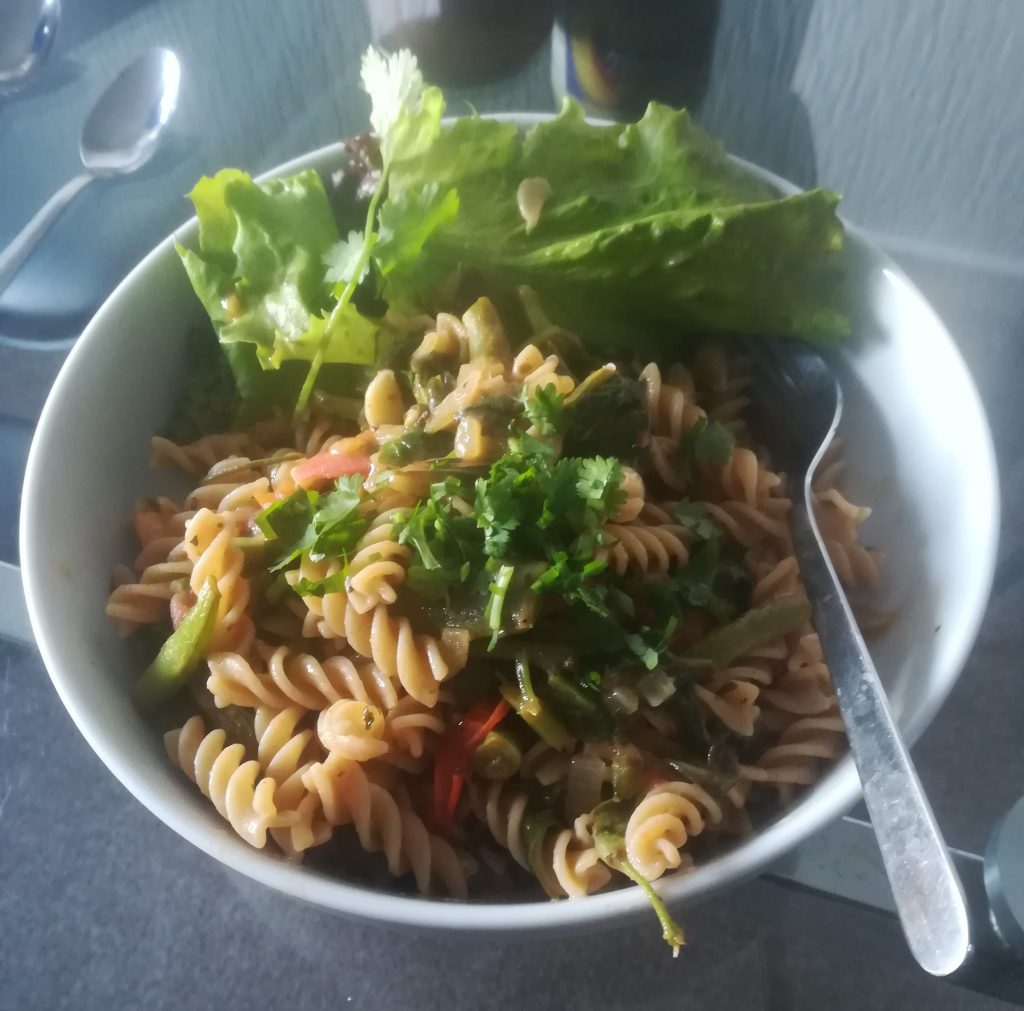
Core Ingredients (for 1 person):
Pasta of your choice, 2 handfuls
Fresh Tomatoes, 1 large handful
Spinach (or other greens depending on share), 3 handfuls
Basil, small handful
Garlic, 1 clove
Lemon Juice 0.5-1 tablespoon or to taste
Olive Oil, 2-3 tablespoons or to taste
Mixed herbs, 1 teaspoon
Optional extras:
Black olives, small handful
Walnuts, small handful
Onion, 1 medium
Green/French Beans, about 3cm bundle
Method:
First chop all your veg; tomatoes into quarters, spinach may need stems chopping down to manageable size, garlic minced or thin slices, onion diced
Next get the pasta on the boil – when it’s ready remember to keep the water!
Whilst the pasta cooks, fry off onion and garlic, then add tomatoes, spinach and any optional extras and fry at a medium heat.
The pasta should be ready about the same time as the veg is cooked. Before draining, add the olive oil to the veg and then add a few sloshes of the pasta water – the starch helps make a good sauce! Then add the lemon juice, basil and mixed herbs and stir it all together until you have a nice shiny consistent sauce. Season with salt and pepper.
Drain the Pasta and add to the pan, mix and serve with some salad on the side and a little chopped coriander on top.
Rob’s Recipe of the Week: Vegan ‘omelette’ for filling
I picked up this recipe whilst living in Gothenburg and it has great connotations for me with sunny breakfasts on the pier… Hopefully I don’t just see it with rose tinted glasses!
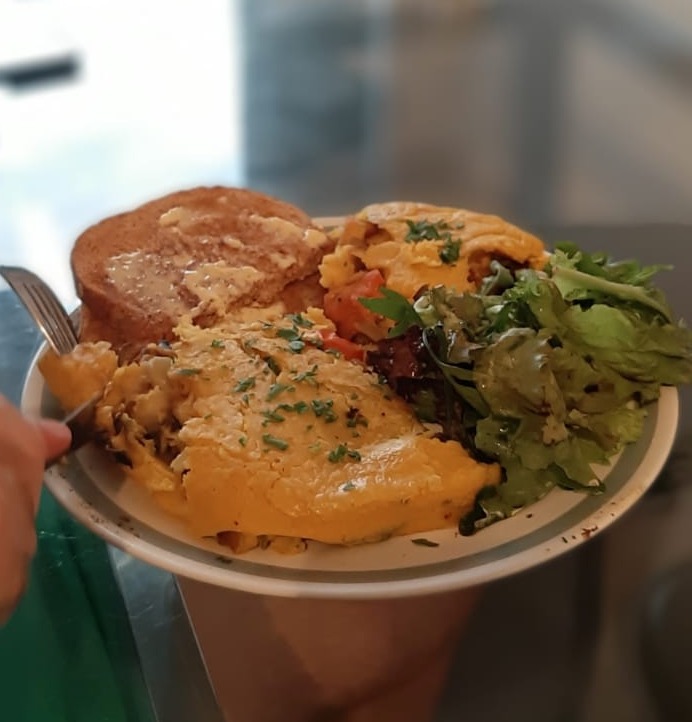
Vegan chickpea flour (kikärtsmjöl) omelette
Ingredients
1 cup (120 g) chickpea flour
1 Tablespoon flaxseed meal or chia seed meal (optional)
1/2 tsp (0.5 tsp) salt
1/4 tsp (0.25 tsp) each of turmeric garlic powder, baking soda, cumin powder
1ish cup of waterFillings!
Fried tomato, onion, mushrooms, lots coming in our shares that could suit!
Method is simple, mix the all the dry ingredients then add the water slowly and mix with a whisk until they take on the same consistency as whisked eggs. Fry up the fillings, then poor on the omelette mix and reduce pan to a medium to low heat. Make sure you cook it slower and longer than an egg omelette – it tends to burn before solidifying enough to flip if you rush it.
Rob’s Recipe of the Week: Dinner on the run
I went to a very interesting sports food recovery workshop with a nutritionist called “whole food warrior” whilst at a running festival earlier in the summer. This is one of her recipes which should be pretty quick and simple, enjoy!
Chickpea, green bean & spinach curry (15-minute recipe)
Ingredients (feeds 2)
For the curry paste:
A handful of fresh coriander, stalks & leaves (10-15g)
1/2 green pepper (75g), roughly chopped
1 red chilli, roughly chopped
1/2 thumb size piece of ginger (15g), peeled and roughly chopped
1 small onion (55g), peeled and roughly chopped
1 turmeric root or 1/4 teaspoon of turmeric powder
1/2 lemon, peeled (you are using the actual lemon here, not the rind)
1 teaspoon of cumin seeds
1/2 teaspoon of cinnamon
sea salt and freshly ground black pepper
Other ingredients:
150g of dwarf beans or green beans
1 tin of chickpeas
1/2 a tin of chopped tomatoes (200ml)
1/2 a tin of coconut milk (200ml)
4 large handfuls of spinach (approximately 120g)
Method:
Put all of the curry paste ingredients in a blender, season with a pinch of sea salt and some freshly ground black pepper and blend until smooth. Add a splash of water to make the bending easier if needed.
Put a frying pan on a medium high heat. Tip in the curry paste and cook until it thickens to a paste, approximately 5 minutes.
Pour in the chopped tomatoes and coconut milk, stir well, season with a little bit more sea salt and black pepper.
Add the green beans and cook for 5 minutes.
Tip in the chickpeas and spinach and cook for a further 5 minutes until the sauce has thickened.
Check the taste and season with more black pepper and sea salt if needed.
To serve, simply divide the curry between two large bowls. Sprinkle on some extra coriander leaves if desired.
Taken from: https://wholefoodwarrior.co.uk/blog/quickcurry
16th aug
Rebecca’s Recipe of the Week: Green Beans, Tomatoes and Saffron
Serve this lovely blend of tomatoes, beans and saffron-scented onions as a side dish, or alongside some polenta topped with a poached egg. It’s also tasty accompanying plain white fish.
Fagiolini in umido all zafferano
Serves 4 as a side dish.
Ingredients
10 medium tomatoes
60ml olive oil
2 medium onions, peeled and thinly sliced
1 small pinch of saffron
650g green beans, topped and tailed
Preparation
Bring a medium pot of water to the boil. Prepare a bowl of ice water.
Score the bottom of each tomato with a X, using a sharp knife, and remove the core. Drop the tomatoes into the boiling water a few at a time, and cook for about 30 seconds each, until the skin starts to loosen. Remove with a slotted spoon and drop into the bowl of ice water. Don’t discard the hot water: you’ll use it to cook the beans.
Fish each tomato out of the ice water and slip off the skin. Dice into small cubes.
Put the olive oil and sliced onions into a saucepan over very low heat. Add a pinch of salt and the saffron. Cook gently for 20-25 minutes, or until the onions are soft and translucent. Stir occasionally and make sure they don’t catch or burn.
Add the diced tomatoes and cook for 10 more minutes. Season with salt.
Bring the tomato water to a boil, salt, and cook the beans for 6 minutes, or until tender. Drain the beans and add to the onion-saffron-tomatoes. Simmer for 3 more minutes over low heat and serve.
Recipe adapted from Christopher Boswell and Elena Goldblatt, Verdure: Vegetable Recipes from the American Academy in Rome (2014).
Rebecca’s Recipe of the Week: Green Beans, Tomatoes and Saffron
Serve this lovely blend of tomatoes, beans and saffron-scented onions as a side dish, or alongside some polenta topped with a poached egg. It’s also tasty accompanying plain white fish.
Fagiolini in umido all zafferano
Serves 4 as a side dish.
Ingredients
10 medium tomatoes
60ml olive oil
2 medium onions, peeled and thinly sliced
1 small pinch of saffron
650g green beans, topped and tailed
Preparation
Bring a medium pot of water to the boil. Prepare a bowl of ice water.
Score the bottom of each tomato with a X, using a sharp knife, and remove the core. Drop the tomatoes into the boiling water a few at a time, and cook for about 30 seconds each, until the skin starts to loosen. Remove with a slotted spoon and drop into the bowl of ice water. Don’t discard the hot water: you’ll use it to cook the beans.
Fish each tomato out of the ice water and slip off the skin. Dice into small cubes.
Put the olive oil and sliced onions into a saucepan over very low heat. Add a pinch of salt and the saffron. Cook gently for 20-25 minutes, or until the onions are soft and translucent. Stir occasionally and make sure they don’t catch or burn.
Add the diced tomatoes and cook for 10 more minutes. Season with salt.
Bring the tomato water to a boil, salt, and cook the beans for 6 minutes, or until tender. Drain the beans and add to the onion-saffron-tomatoes. Simmer for 3 more minutes over low heat and serve.
Recipe adapted from Christopher Boswell and Elena Goldblatt, Verdure: Vegetable Recipes from the American Academy in Rome (2014).
Rebecca’s Recipe of the Week: A Warm Salad of French Beans with Gingery Noodles
Warm Japanese noodles and bright green vegetables, tossed with a sharp, gingery dressing make a quick and delicious dinner. The whole thing comes together in under 25 minutes. I think you could add some toasted, chopped peanuts to the top, as well.
The dressing is also very good tossed onto shredded cabbage and kohlrabi, for a punchy slaw.
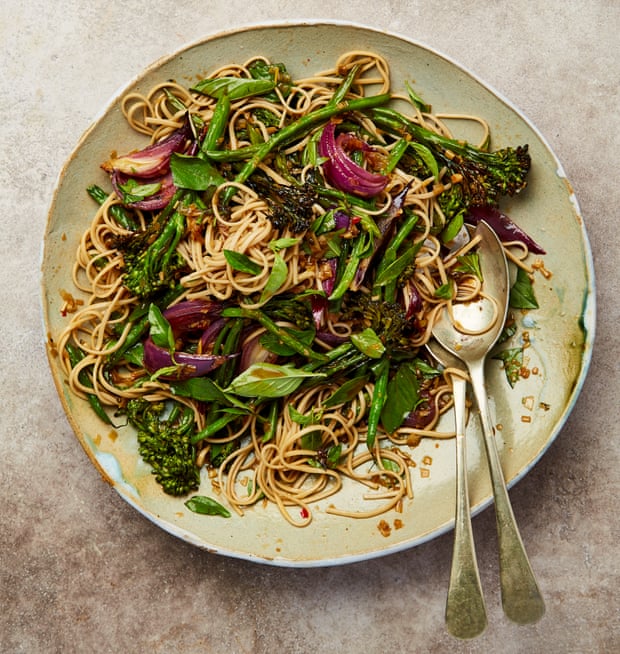
Charred broccoli and bean soba noodle salad
Serves 2
Ingredients
For the salad
450g French beans and/or broccoli (any combination)
2 red onions, peeled and cut into 8 wedges
2 tbsp rapeseed oil
¼ tsp salt
200g soba noodles, or a mixture of soba and udon noodles
¼ cup Thai basil and/or mint leaves, roughly chopped
For the dressing
4 spring onions (use the whole thing), finely chopped
4cm piece fresh ginger, peeled and finely grated
3 tbsp toasted sesame oil
3 tbsp rice wine vinegar (Meera Sodha specifies black Chingkiang vinegar)
4 tbsp light soy sauce
1 tbsp brown rice (or maple) syrup
1 dried red chilli, finely chopped, or de-seeded and then left whole if you’d like the option of removing it later
Preparation
Pre-heat the oven to 220C.
Trim the broccoli into long, slender strips. You can include the green leaves if you like, as well. Top and tail the beans.
Place the broccoli and/or beans and onion wedges on a baking tray. Drizzle over the oil and sprinkle with salt. Mix with your hands, and roast for 10-20 minutes, until they are a bit charred and the leaves have become crispy.
Bring a large pan of water to a boil, then cook the noodles according to packet instructions. Drain and rinse under cold water, then leave to one side to drain.
For the dressing, put all the ingredients in a small saucepan, bring to a boil, then take off the heat and put to one side.
When the vegetables have cooked, tip them into a serving bowl, add the drained noodles and dressing, and toss. Toss in the herbs, and serve while the vegetables are still a little warm.
Recipe adapted from Meera Sodha, The Guardian, 22 June 2019.
Ali’s Recipe of the Week: One for the Store-cupboard
Rebecca’s having a break this week and hopes to be back with another recipe next week.
With the cauliflower crop getting going, the moment may have arrived to do the first preserving of the year (that is, if you haven’t already made marmalade, perhaps using some delicious La Jimena seville oranges).
Piccalilli is as versatile as any savoury preserve in that you can flex the recipe according to what is available. Most piccalilli recipes call for courgettes, green beans, tomatoes, and other summer veg. However, if all you have is roots and PSB (purple sprouting broccoli) that combination will also make a perfectly good version of this tangy preserve. Luckily my book of preserves from the Women’s Institute can oblige with a suitably flexible recipe for any time of year! I’ve been know to make a version with cauliflower, onions (admittedly these are perhaps the two essential vegetables), carrot and swede!
Many piccalilli recipes call for the vegetables to be brined overnight, but this one breaks that rule, which simplifies the recipe and results in a delicious accompaniment for a ploughman’s lunch. And unlike chutneys which rely on evaporation of the liquid to thicken the preserve (which can sometimes take hours), as this one is thickened with flour it has a much shorter cooking time.
Accommodating Piccalilli from the W.I.
Makes about 2.7kg (6lb) = 6 average sized jam jars
Preparation time: 45 minutes
Cooking time: 30 minutes
Ingredients
1 large cauliflower, broken into florets
450g (1lb) pickling onions – if you’ve still got any little Canalside onions left, they’d be perfect!
1.4L (2 1/2 pints) white malt vinegar (apple cider vinegar also works well)
900g (2lb) mixed vegetables, diced or cut into 2.5cm (1 inch) lengths
2 fat cloves of garlic
450g (1lb) caster sugar
50g (2oz) dry mustard (i.e. mustard powder)
115g (4oz) plain white flour, sieved
25g (1oz) ground turmeric
1 tsp ground coriander
2 tsp salt
Preparation
In a large preserving pan, summer the cauliflower and onions in 1.1litres (2 pints) of the vinegar for 10 minutes.
Add the other vegetables, garlic and sugar and cook for a further 10 minutes.
Mix the mustard, flour. spices and salt with the remaining vinegar and add to the cooked vegetables, stirring all the time to prevent lumps from forming.
Stir well and simmer for a further 10 minutes.
Spoon into cooled and sterilised jars and cover with vinegar proof tops. Label and store for at least 2 weeks before using. It will keep for months (I think I’ve even kept it for more than a year) with the flavour improving and mellowing as it ages.
From ‘Best Kept Secrets of the Women’s Institute: Jams, Pickles and Preserves’ by Midge Thomas
Rebecca’s Recipe of the Week: Dips
What could be more 1970s than a dip? Bowls of sour cream blended with onion soup mix, or pink concoctions featuring a lot of mayonnaise served with crisps may have a retro appeal but here is an up-to-the minute dip you can serve without a heavy dose of irony. It features roasted pumpkin or butternut squash, toasted nuts and a zing of fresh mint. Spread it on triangles of toasted pita, or thin slices of toast. It also freezes very well, in case you don’t eat it all in one go.
Vaguely Greek Squash and Walnut Dip
Makes about 2 cups
Ingredients
1 kg pumpkin or winter squash
35g walnuts or hazelnuts
2 tablespoons olive oil
1 medium onion (or the equivalent in tiny Canalside onions), finely chopped
2 tablespoons finely-chopped mint
1/8 teaspoon freshly-grated nutmeg
40g parmesan cheese (or other sharp, hard cheese)
Preparation
Preheat the oven to 200C.
Cut the squash or pumpkin into large pieces, remove the seeds (you can keep these to roast as a nibble), and peel.
Place the squash on a baking tray, put in the oven, and roast until it’s very tender—between 40 minutes and an hour. Turn it occasionally if you remember, so that it browns a bit on all sides. When it’s soft, remove it and let it cool.
Turn the oven to 150C and put the nuts on another tray. Once the oven has cooled down put the nuts in and toast them for 5-10 minutes, or until they smell fragrant and are ever so lightly brown.
Heat the oil in a small pan over low heat and add the onion. Cook it gently until it’s very tender, sweet and lightly caramelised—about 20 minutes. Remove from the heat.
Combine the onion, cooked squash, nuts, mint, nutmeg and cheese in a bowl and blend with an immersion blender (or food processor) until the mixture is pleasantly smooth. Taste and season with salt and pepper to taste. Serve on little pieces of toast, or crackers.
Recipe adapted from Martha Rose Schulman in the New York Times (2012).